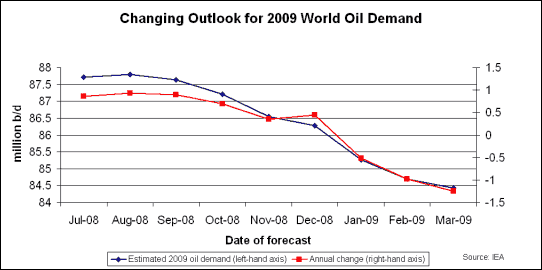The turbulence of the past year has been particularly felt by the member
states of OPEC, whose economies depend heavily on oil revenues and enjoyed
an unprecedented windfall as oil prices soared in 2008.
At the same time, the upwards March of prices exposed the apparent inability
of the cartel to control prices.
| OPEC countries have felt the pinch and embarked on a series of production cuts to remove excess supply from the market. |
Then as prices fell even more dramatically, OPEC countries have felt the
pinch and embarked on a series of production cuts to remove excess supply
from the market.
Those cuts are still being implemented, and with the outlook for oil demand
and non-OPEC supply both far from clear, OPEC is certain to be keeping en
even closer eye than usual on market developments in the coming months.
Changing outlook for 2009 world oil demand (million b/d)

At its first meeting of 2008, at the beginning of February, OPEC ignored
lobbying by the US to increase production and opted for a rollover of
official limits.
Little over a month later, OPEC ministers met again days after oil touched
$100/barrel for the first time.
Once more they decided to do nothing, blaming rising prices on a litany of
factors beyond their control, including the weak dollar, geo-political risk
and "speculation."
They also decided not to schedule another meeting until September, a full
six months away.
But with prices continuing to rise through the second quarter, OPEC
was never out of the spotlight for long.
In June, Saudi Arabia's King Abdullah called an unprecedented meeting of oil
producers and consumers in Jeddah to discuss the record prices.
Everyone agreed the high prices--which by that stage had already been above
$130/b--were bad for the world economy, but there was no real consensus on
the causes.
The US and UK said there was a shortage of supply while Saudi Arabia said
fundamentals were not to blame.
Indeed, shortly after the Jeddah meeting, Qatar's veteran oil minister
Abdullah al-Attiyah even said the market was oversupplied with crude.
By September, the mood had changed, with prices now falling even more
precipitously than they had risen during the first half of the year and
already back at $100, down from July's peak of more than $147/b.
OPEC did not raise crude production quotas during the first half of 2008 but
had turned a blind eye to volumes being pumped above official limits while
the market was over-heating.
But now, alarmed by the rapidly falling market, it said it wanted its
members to bring supply back to quota levels, which implied an actual supply
cut of just over 500,000 b/d.
By late October, with prices sliding towards $60/b, OPEC called an emergency
meeting in Vienna and agreed a 1.5 million b/d production cut.
Two months later, in the Algerian city Oran, OPEC made history with the
biggest cut in its history, wrapping up the two previous reductions and one
new one in a total package designed to cut a total of 4.2 million b/d from
the group's estimated production in September.
In the short term prices shrugged off OPEC's action, and even fell by more
than $3/b on the day of the Oran meeting to nearly $40/b.
In 2009 the story so far for OPEC has been one of compliance.
Evidence has been mounting everywhere of production cuts by the cartel's
members, with term buyers being given lower volumes and secondary sources
estimating that the group had implemented around 80% of the total 4.2
million b/d cut by February.
By this time, of course, OPEC was having to deal not only with the massive
fall in oil prices but also the specter of a global recession, with its own
profound implications for oil demand.
By March, the cuts seemed to be having some effect on oil prices, which had
risen back above $50/b despite the signs of oil demand collapsing around the
world.
OPEC met again in March, and voiced its determination to reach full
compliance with the cuts by removing the estimated production of around
800,000 b/d above the official quotas.
This last 20% could prove the trickiest part to cut, however, with it
becoming increasingly clear that the burden of restricting output is not
being shared equally by all OPEC countries.
For the rest of the year, the group will be extremely anxious not to allow a
stagnant economy to be over-supplied with oil it doesn't want.
The key, therefore, is likely to be the depth and extent of the economic
downturn - if things keep on getting worse then there are likely to be calls
from some quarters of OPEC for supply to cut as well.
On the other hand, if confidence can return to markets, investors and
consumers, then the way ahead will look a little clearer for OPEC.
Even under more optimistic scenarios, 2009 could be a testing time for OPEC,
with many of the group's members having to accept that the average oil price
for the year is likely to fall well short of what they had been hoping for
when annual budgets were first drawn up.
|